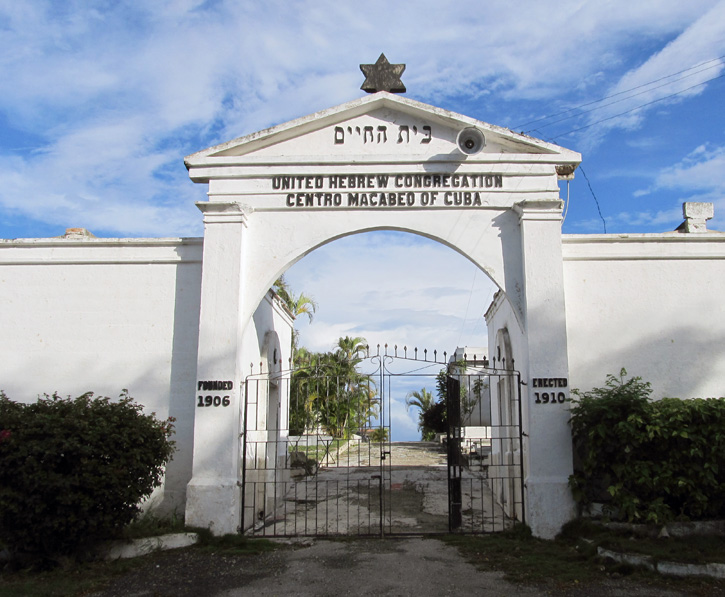Today, Havana’s Jewish community (La Comunidad Hebrea) numbers only about 1,500, about 5 percent of its prerevolutionary size, when it supported five synagogues and a college.
The first Jew in Cuba, Luis de Torres, arrived with Columbus in 1492 as the explorer’s translator.The first Jew in Cuba, Luis de Torres, arrived with Columbus in 1492 as the explorer’s translator. He was followed in the 16th century by Jews escaping persecution at the hands of the Spanish Inquisition. Later, Jews emigrating from Eastern Europe passed through Cuba en route to the United States in significant numbers until the United States slammed its doors in 1924, after which they settled in Cuba.
The United Hebrew Congregation Cemetery in Guanabacoa was the first Jewish cemetery in Cuba. Photo © NatalieMaynor, licensed Creative Commons Attribution.
By the 1950s, about 20,000 Jews lived in Havana, concentrated around Calle Belén and Calle Acosta, which bustled with kosher bakeries, cafés, and clothes stores. Jews knew the lessons of Nazi Germany and the totalitarian regimes of Eastern Europe and so, following the Revolution, became part of the Cuban diaspora. About 95 percent of them fled.
Although the Castro government discouraged Jews from practicing their faith, Jewish religious schools were the only parochial schools allowed to remain open after the Revolution. The government has always made matzo available and even authorized a kosher butcher shop to supply meat for observant Jews.
Although the community has no rabbi, a renaissance in the Jewish faith is occurring. A Hebrew Sunday School even teaches Hebrew and Yiddish.
Habana Vieja’s Jewish quarter features the Sinagoga Adath Israel (Picota #52, esq. Acosta, tel. 07/861-3495, daily 8am-noon and 5pm-8pm), with a wooden altar carved with scenes from Jerusalem and historic Havana. Nearby is the Parque de Los Hebreos (Calle Acosta esq. Damas), with a giant menorah, the Jewish candelabra. Chevet Achim (Inquisidor, e/ Luz y Santa Clara, tel. 07/832-6623) was built in 1914 and is the oldest synagogue in Cuba. The building is owned and maintained by the Centro Sefardi but is not used. It can be viewed by appointment.
In Vedado, the Casa de la Comunidad Hebrea de Cuba (Calle I #253, e/ 13 y 15, tel. 07/832-8953, Mon.-Fri. 9:30am-5pm), or Patronato, is the Jewish community headquarters. Services at the adjacent Bet Shalon Sinagogo are Friday at 7:30pm (May-Sept.) or 6pm (Oct.-Apr.) and Saturday at 10am (year-round). Nearby, the Centro Sefardí (Calle 17 #462, esq. E, tel. 07/832-6623) hosts a Holocaust museum.
Guanabacoa, on the east side of Havana harbor, has two Jewish cemeteries. The Cementerio de la Comunidad Religiosa Ashkenazi (Av. de la Independencia Este, e/ Obelisco y Puente, tel. 07/97-6644, Mon.-Fri. 8am-11am and 2pm-5pm), also known as the United Hebrew Congregation Cemetery, is for Ashkenazim. It is entered by an ocher-colored Spanish-colonial frontispiece with a Star of David. A Holocaust memorial immediately to the left of the gate stands in memory of the millions who lost their lives to the Nazis. Behind the Ashkenazi cemetery is the Cementerio de la Unión Sefardi (Calle G, e/ 5ta y Final, tel. 07/97-5866, daily 7am-5pm), for Sephardic Jews. It too has a memorial to the Holocaust victims.
The following organizations send humanitarian aid to Cuba and/or offer organized trips: the Cuban Jewish Relief Project (tel. 877/222-9590), the Cuba-America Jewish Mission, and Jewish Solidarity (tel. 305/642-1600).
Excerpted from the First Edition of Moon Havana.